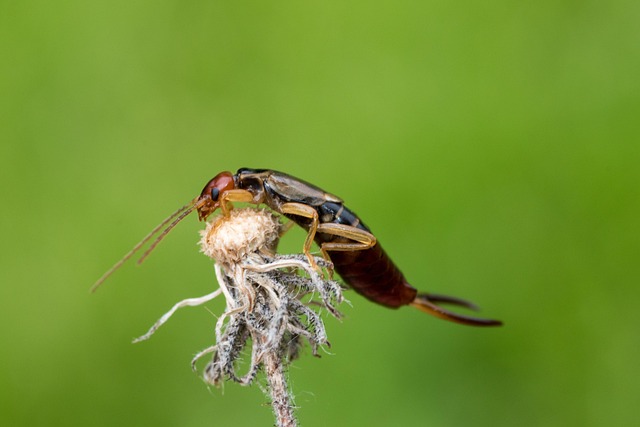Earwigs, contrary to popular belief, are harmless and primarily feed on plants. Infestation management requires tailored strategies like sealing entry points, addressing moisture issues, and using eco-friendly baits or traps. Customized earwig control plans, emphasizing integrated pest management (IPM), disrupt breeding patterns while preserving the environment. These plans, adaptable based on monitoring data, ensure effective and sustainable earwig population control. Preventive measures include physical barriers, safe pesticide treatments, regular inspections, and good hygiene practices to deter earwigs and reduce future infestation risks.
“Uncover the truth behind earwig infestations! This comprehensive guide separates myth from reality, addressing common misconceptions that often surround these nocturnal creatures. From understanding their behavior to creating effective prevention strategies, we provide insights into managing and controlling earwig populations.
Learn about the science behind customized earwig control plans, tailored to specific environments, ensuring efficient and targeted solutions. Discover practical tips and expert advice to protect your space from these critters, promoting a peaceful and pest-free co-existence.”
Understanding Earwigs: Myths vs. Reality
Earwigs are often misunderstood creatures, leading to a host of myths surrounding their behavior and impact on homes and gardens. Let’s dispel some common misconceptions. Contrary to popular belief, earwigs aren’t interested in piercing human ears; they primarily feed on plants and other insects. While they may look intimidating with their long antennae and pincers, these creatures play a beneficial role in the ecosystem by controlling insect populations.
When it comes to infestations, customized earwig control plans are key. Instead of relying on harsh chemicals, professionals can implement targeted strategies like sealing entry points, removing moisture sources, and using specific baits or traps. This not only ensures effective earwig management but also promotes a safer, more eco-friendly environment.
Common Misconceptions About Earwig Infestations
Many people have misconceptions about earwig infestations, often fueled by urban legends and unsubstantiated fears. One common myth is that earwigs are aggressive and pose a direct threat to humans. In reality, earwigs primarily feed on plants and only rarely bite humans, and their bites are not harmful. They prefer dark, moist environments, which is why they’re often found in kitchens, bathrooms, or basements—not within the human ear as the name might suggest.
Another misconception is that an earwig infestation requires drastic or toxic solutions for control. However, customized earwig control plans using integrated pest management (IPM) strategies can be highly effective. These methods include identifying and sealing entry points, removing moisture sources, using sticky traps, and applying targeted pesticides when necessary. Professional pest control services can design such plans, ensuring safe and efficient earwig prevention and management tailored to your specific situation.
Developing Customized Earwig Control Plans
When dealing with earwig infestations, a one-size-fits-all approach rarely works effectively. This is where developed customized earwig control plans come into play. These tailored strategies consider unique environmental factors, such as vegetation and weather patterns, to implement targeted methods that are both efficient and environmentally friendly. By assessing the specific needs of each location, professionals can determine the best course of action, whether it involves biological control, chemical interventions, or a combination of both.
Customized plans also account for the life cycle of earwigs, targeting them at various stages to disrupt their breeding patterns. This precision approach not only ensures better control but also reduces potential harm to non-target species and the environment. Moreover, these strategies can be regularly adjusted based on ongoing monitoring, ensuring that any changes in the earwig population or environmental conditions are promptly addressed.
Effective Strategies for Preventing Future Infestations
Preventing future earwig infestations is key to maintaining a pest-free environment. Customized earwig control plans are often the most effective approach, addressing specific needs and conditions unique to each property. These tailored strategies can include a combination of physical barriers, such as sealing entry points and installing traps, along with targeted treatments using safe and eco-friendly pesticides. Regular inspections play a crucial role too; identifying and mitigating potential habitats early on can stop infestations in their tracks.
Additionally, maintaining good hygiene practices, like keeping areas clean and dry, especially in kitchens and bathrooms, discourages earwigs from seeking shelter. Proper waste management, including regular disposal of organic materials, also helps as earwigs are attracted to decaying matter. By implementing these preventive measures, homeowners can significantly reduce the risk of future earwig infestations and enjoy a more comfortable living space.
Earwigs, often shrouded in myth and misunderstanding, can cause significant distress when they invade homes. However, by separating fact from fiction, we can develop effective, tailored strategies for control through customized earwig control plans. Armed with knowledge about their behavior and the right tools, it’s possible to prevent future infestations and reclaim a peaceful living environment.
